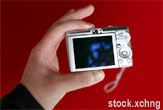Researchers Aim for Single-Pixel Camera

Imagine a digital camera that not only takes up less power and space, but can also take night-vision pictures as well.
A digital camera that records pictures in the infrared and the ultraviolet as well as the visible range could work using just a single-pixel light sensor, as opposed to the million-pixel sensors digital cameras now employ.
This single-pixel camera could drain less power and take up less space without sacrificing image detail, researchers add.
Conventional digital cameras employ arrays of millions of light sensors. These work together to record images as a series of points called pixels. The problem is all this data is too much to store, meaning compression algorithms are often used to shrink picture files in size.
"For one thing, this compression really drains the camera battery power," researcher Richard Baraniuk, an electrical engineer at Rice University in Houston, told LiveScience. "It's also overkill. You're using, say, five million detectors in a five megapixel camera, but throwing away most of the data."
Breakthroughs in mathematics in the last two years have led to a bizarrely counterintuitive advance, Baraniuk explained. Essentially, if cameras scan in a fraction of pixels from throughout a scene—say, 3 or 4 percent, or just thousands of pixels—new algorithms can take such data and extrapolate out what the original image appeared like. This means the compression step can get cut and fewer light detectors are needed, which together would save power and space.
Instead of employing thousands of detectors to record megapixel images, which in itself would be an advance, Baraniuk with electrical engineer Kevin Kelly and their colleagues are trying to use just one pixel detector. Basically, instead of having thousands of detectors each simultaneously scanning a scene once, these researchers are using a single detector to rapidly scan for data from thousands of pixels. The researchers will present their findings regarding the first such single-pixel camera on Oct. 11 at the annual meeting of the Optical Society of America in Rochester, N.Y.
Sign up for the Live Science daily newsletter now
Get the world’s most fascinating discoveries delivered straight to your inbox.
Aside from saving power, the researchers explain that a single-pixel camera could also capture different kinds of light aside from the visible, such as infrared or ultraviolet, "so you could do neat things like night-vision or low-light cameras," Baraniuk said. This would involve a fancier and more expensive light detector, something easier to implement with cameras using just one such detector as opposed to thousands.
In the future, the researchers will try to boost the speed at which their camera records data in order to capture more pixels for higher-resolution pictures. So far they can take one snapshot of a single pixel in a few milliseconds, which can get extrapolated to 3,000 recordings a minute for a 128 by 128 pixel image. They hope to boost that "by a thousand times in the near future," Kelly said.
Future designs could also work with more uncommon kinds of light, such as x-rays or terahertz radiation. However, these require equally uncommon light sources, restricting them from consumer use.










